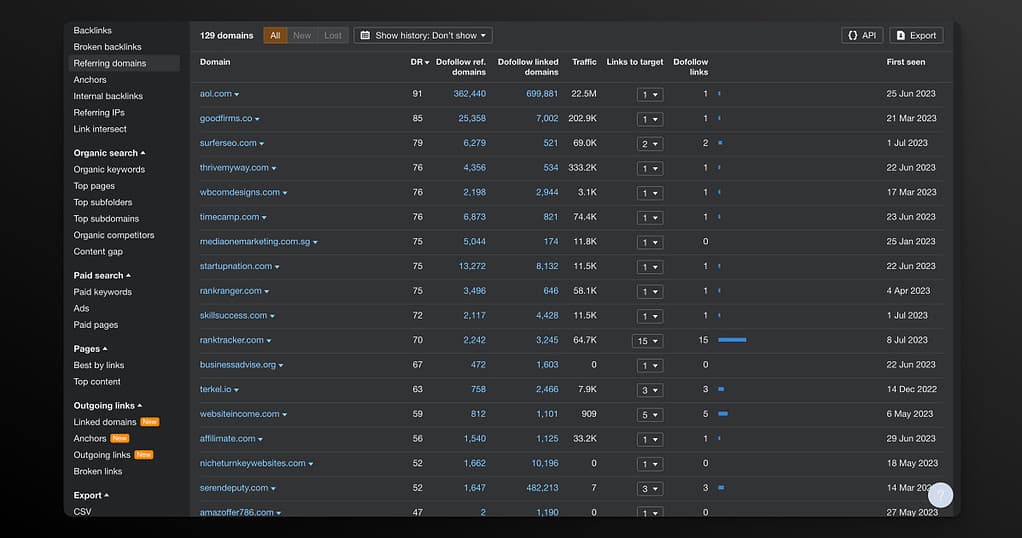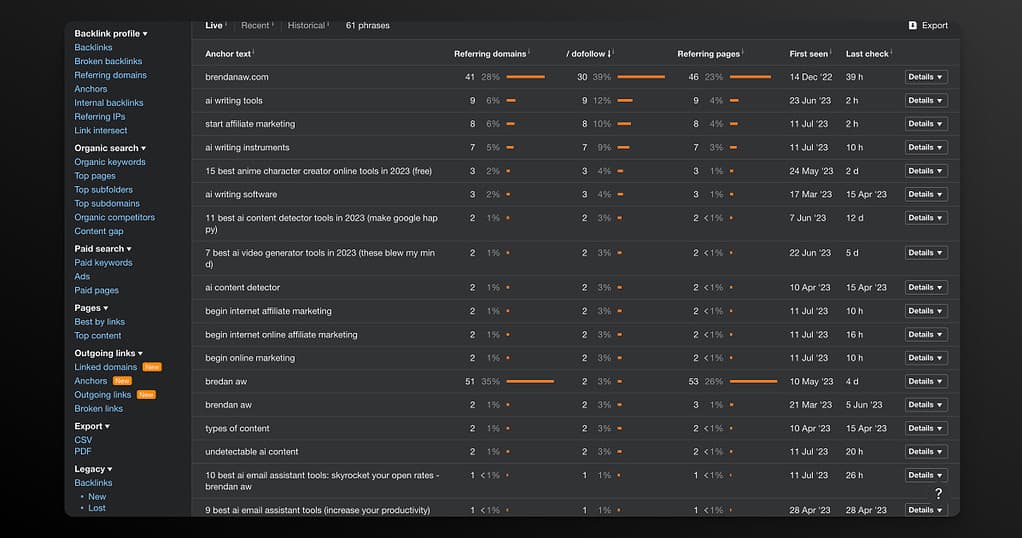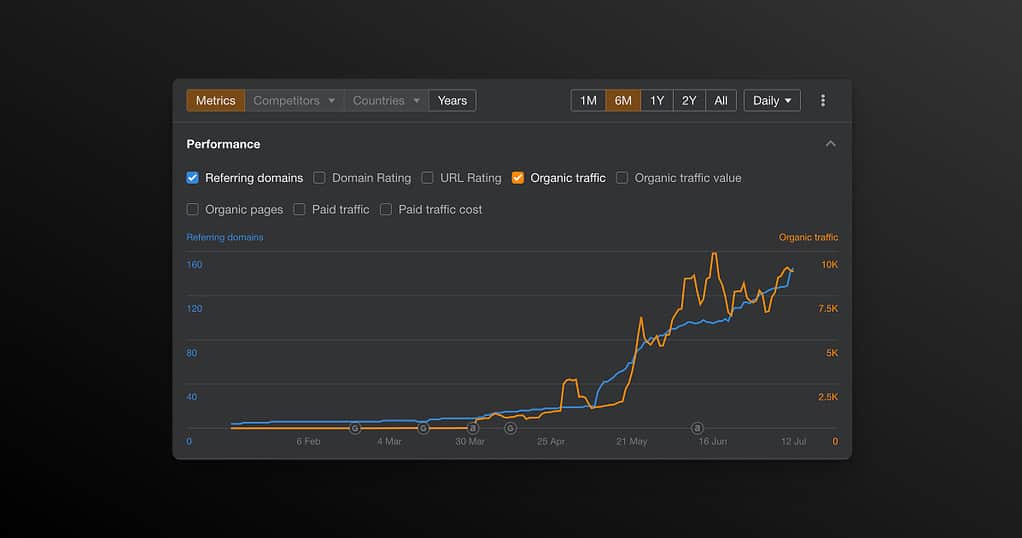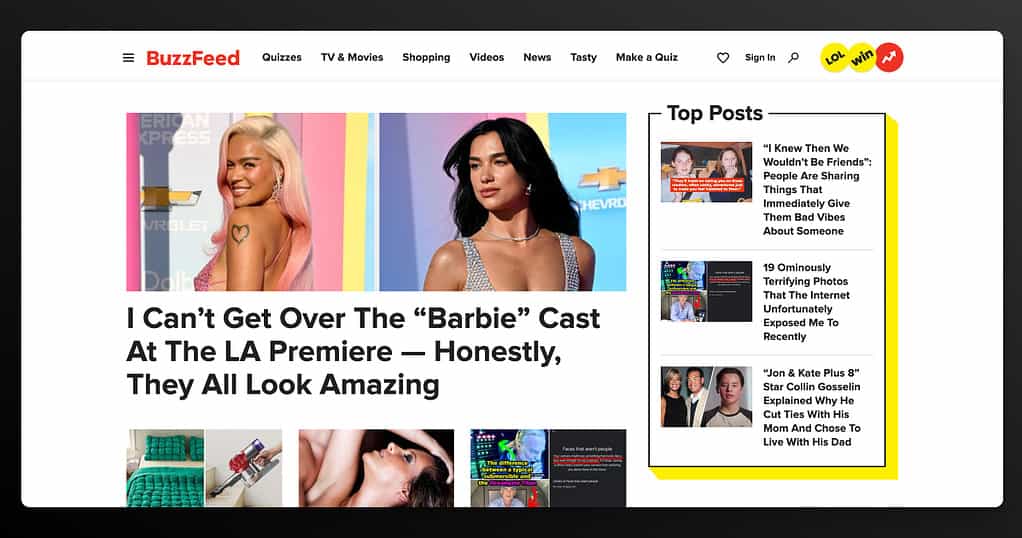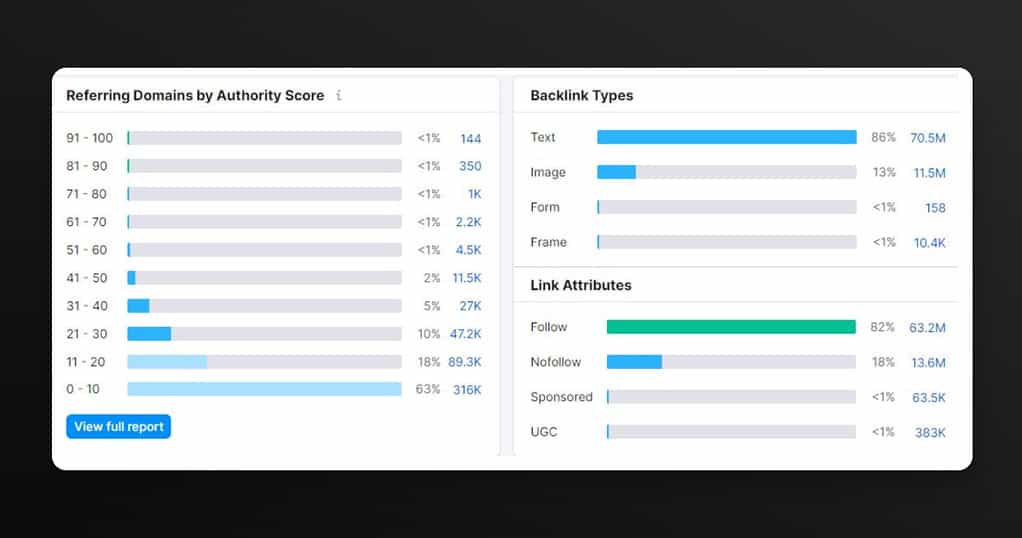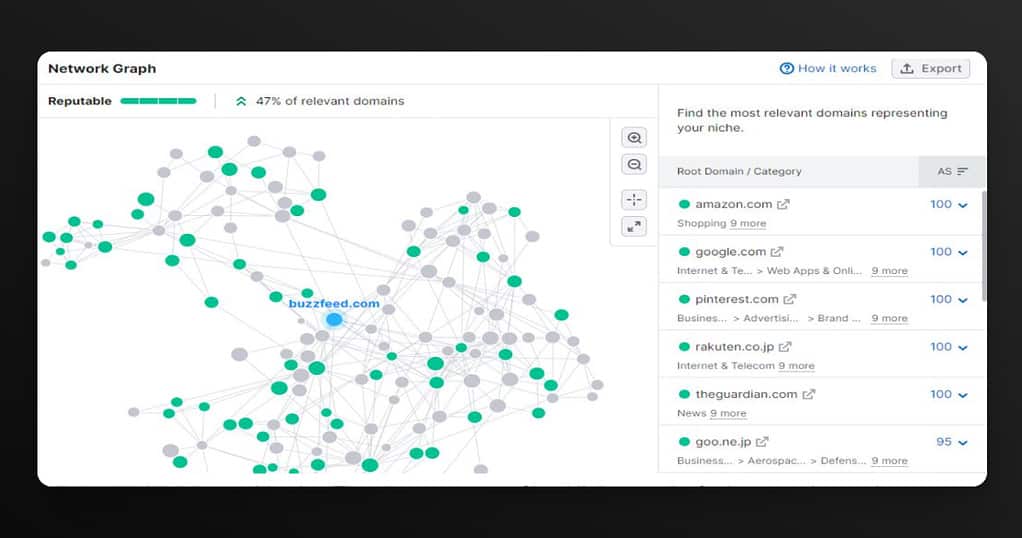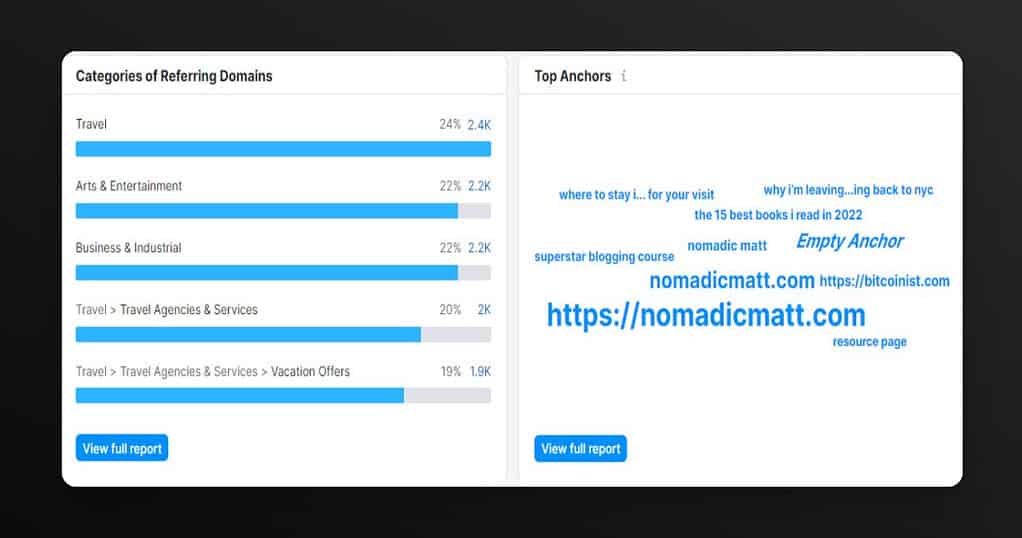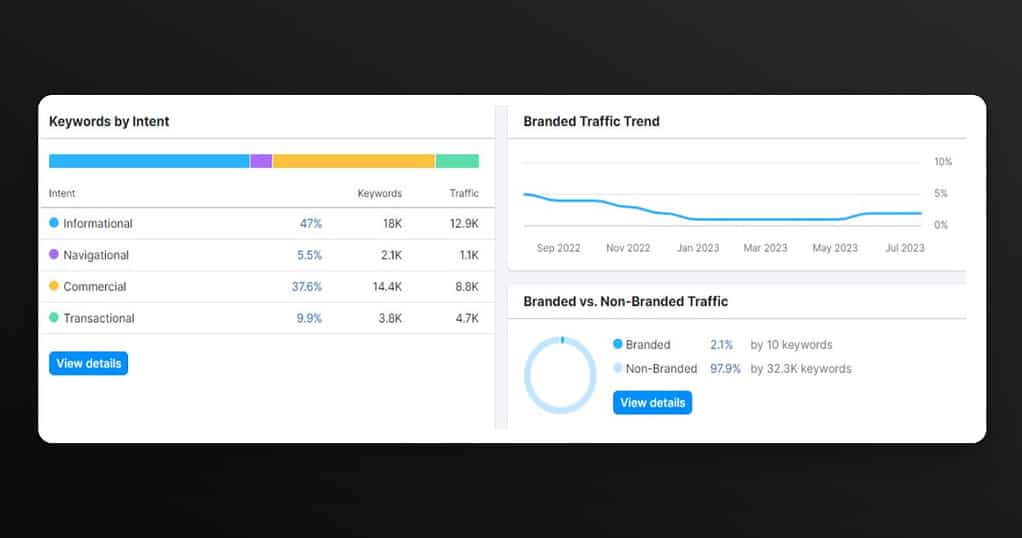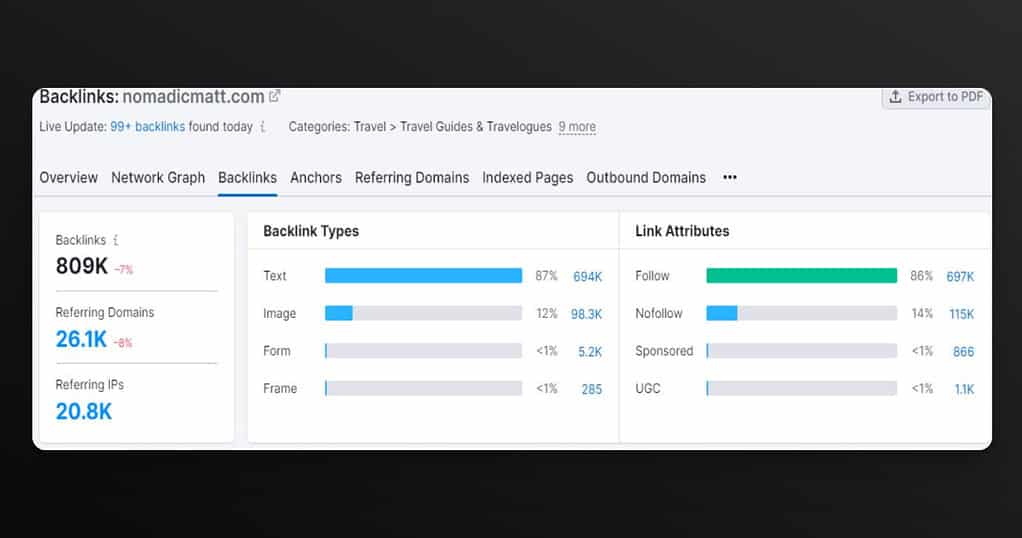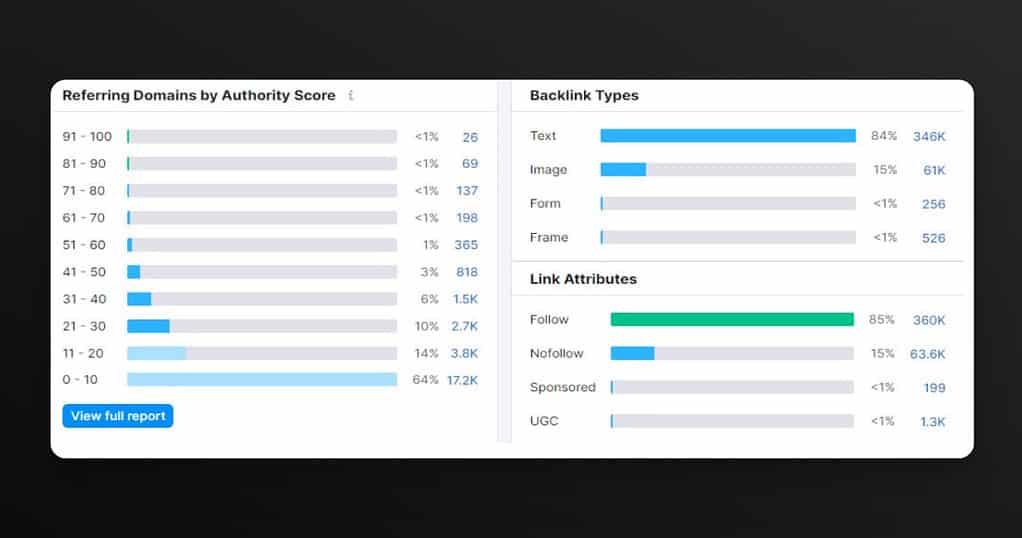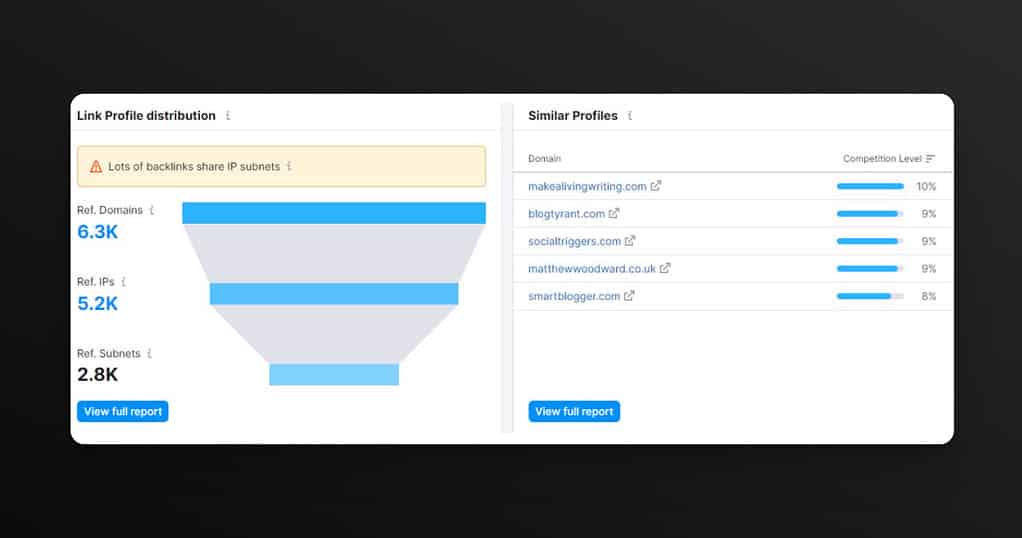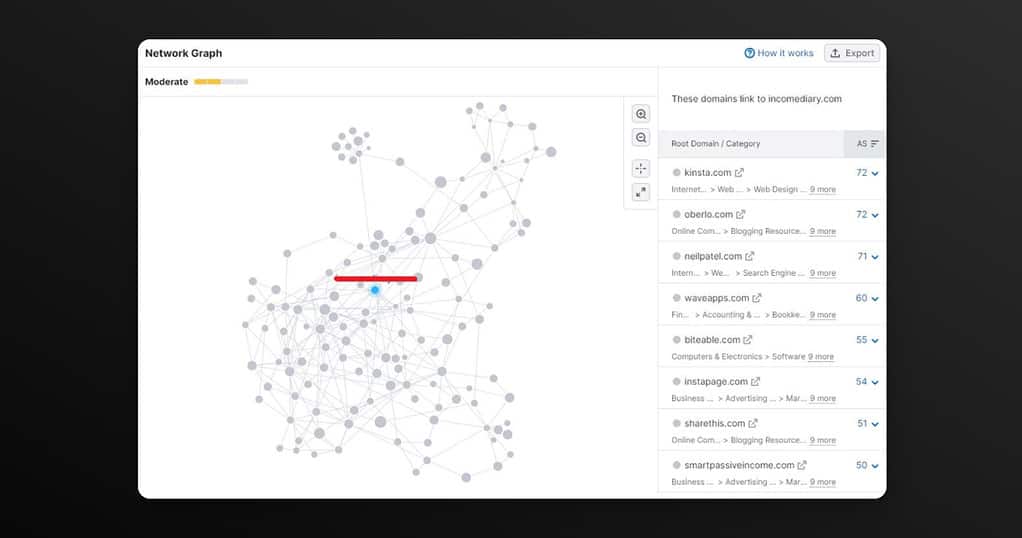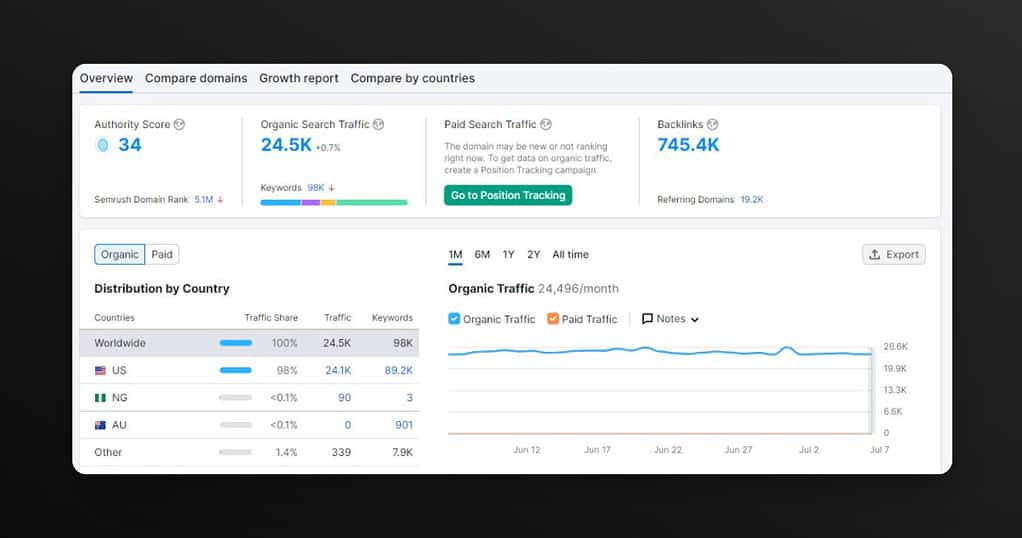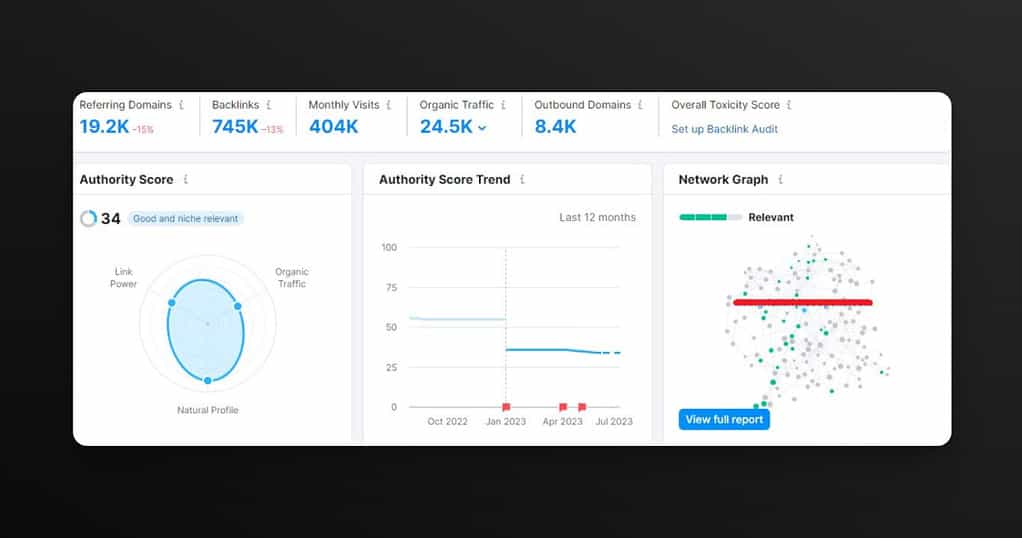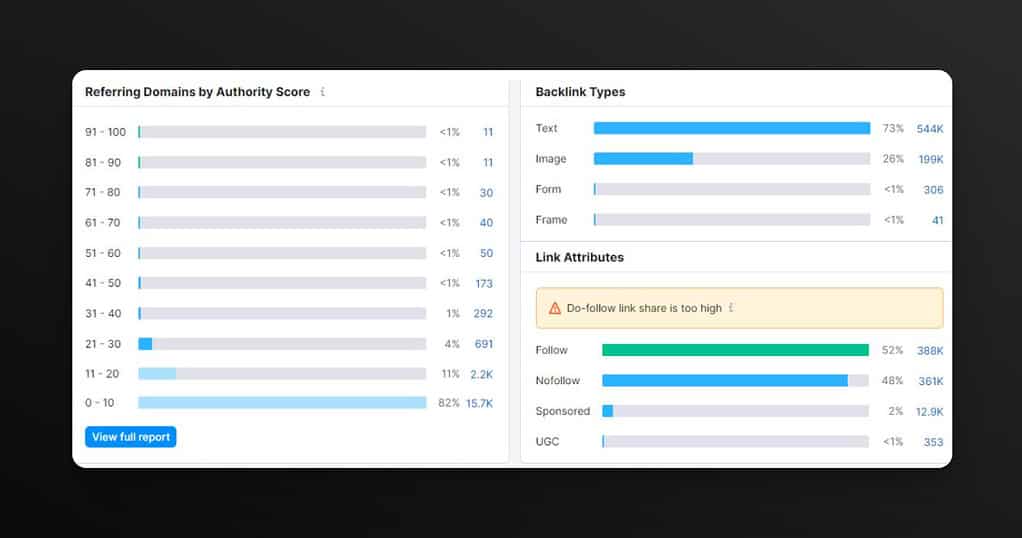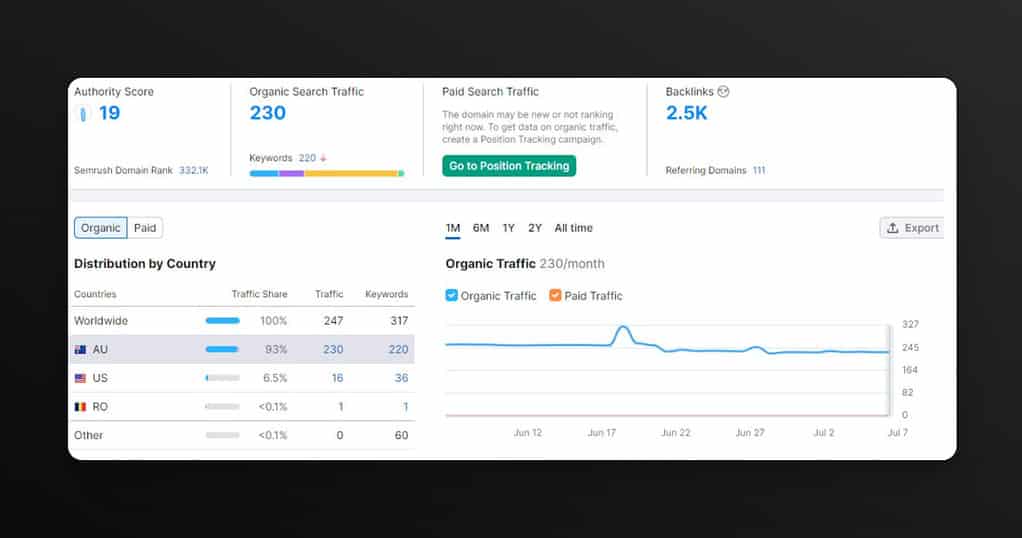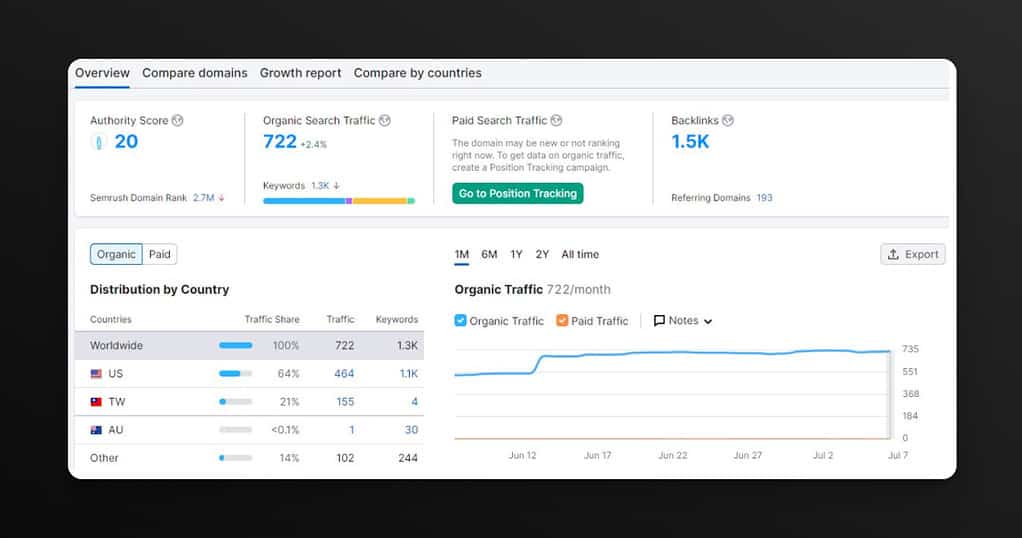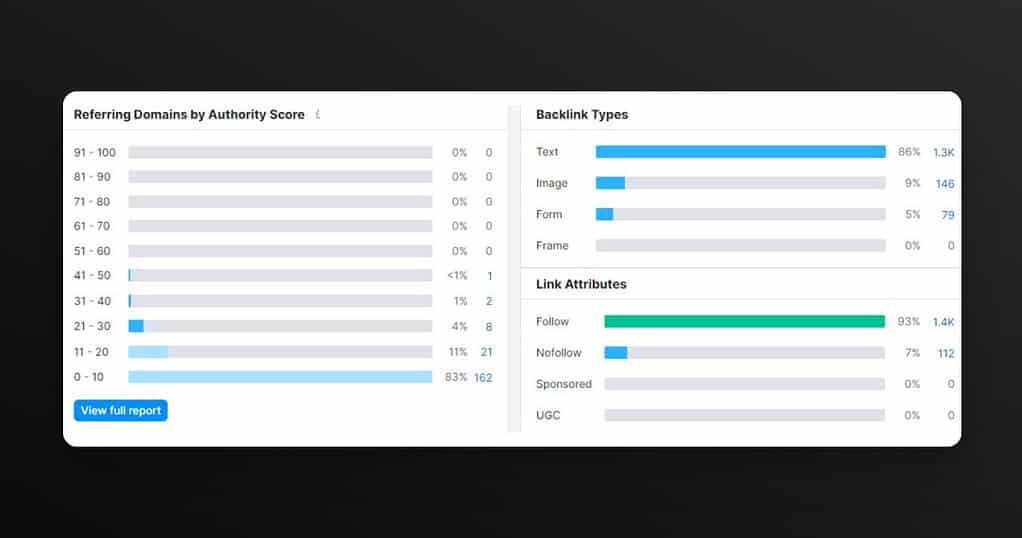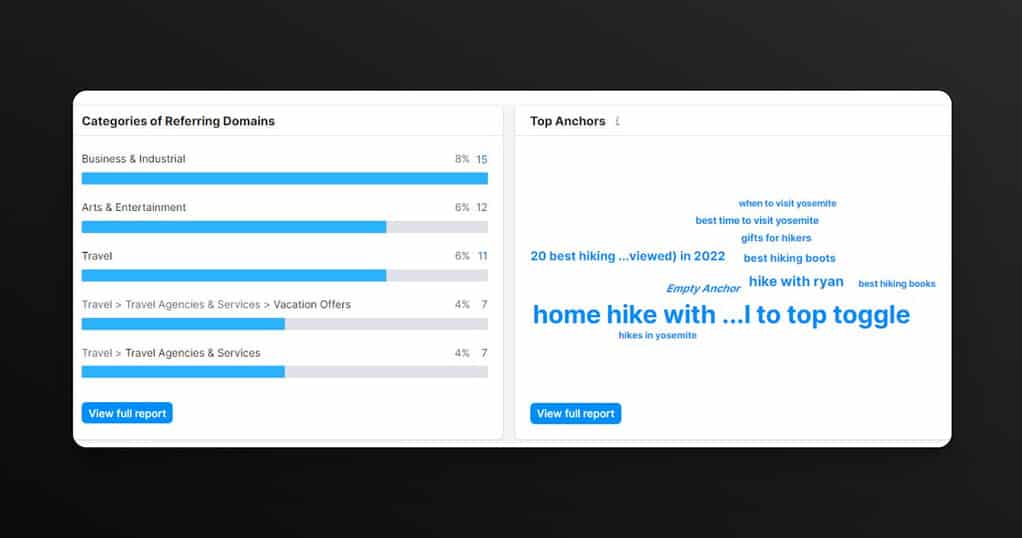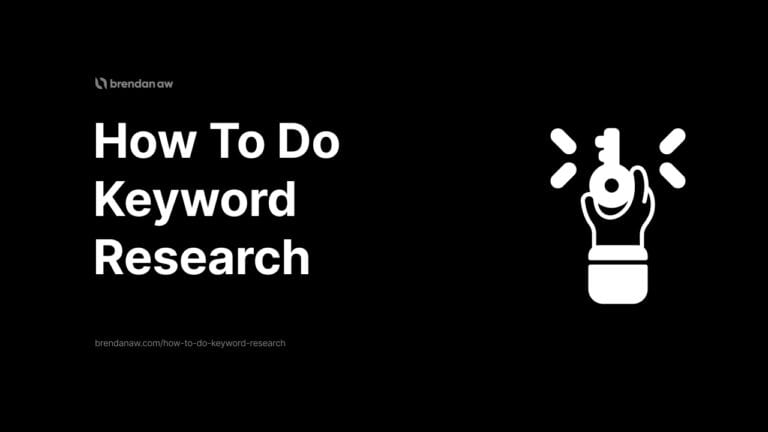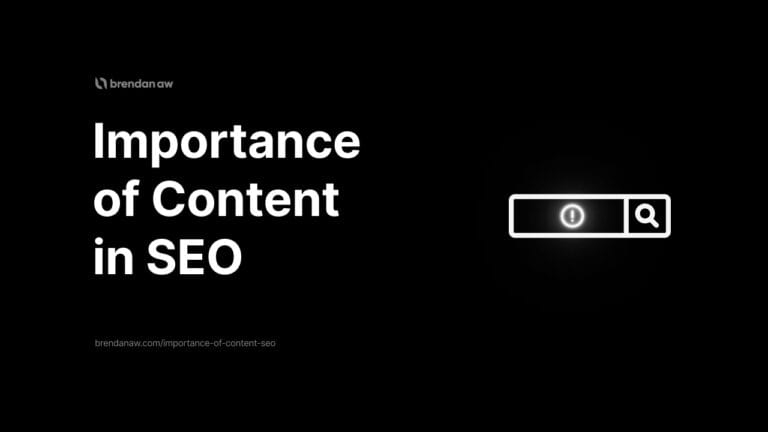Struggling to understand the impact of your backlink profile on your website’s SEO success? In this ultimate guide, we delve deep into the nitty-gritty details.
You kinda know having a solid backlink profile is crucial to SEO success.
But why?
If you’re a new website owner or just new to SEO…
- How exactly can you know if you’re going in the right direction?
- What factors affect your backlink profile?
- How to effectively analyze yours for better performance and rankings?
- Is your backlink profile good or bad?
These are some of the questions I’ll be answering in this article.
If that sounds good…
Continue reading.
What Is a Backlink Profile?
A backlink profile is the entire portfolio of backlinks that point back to a certain website. It’s a breakdown of your website’s authority, relevance, and quality.
Having a good one determines how well your site will rank in search engine results.
Elements of a backlink profile include:
- The types of backlinks (do-follow, no-follow, etc.)
- The anchor texts
- Domain authority of referring websites
- Context and relevance
These elements will be assessed by Google in determining the trustworthiness, expertise, and credibility of a website.
And it can be measured using AI SEO tools like Semrush, Ahrefs or Moz.
Importance of a Backlink Profile for SEO
Now that you know what it is…
Why is it important specifically for SEO?
Here are a few reasons why.
Serves as a Trust Signal
Each link acts as a confidence signal to search engines that one website is vouching for another.
Ever since the inception of Google’s PageRank algorithm…
It played a central role in determining rankings.
This still serves as the foundation for evaluating a solid backlink profile and other ranking factors.
But the focus is now on quality over quantity.
Did You Know: Low-quality and irrelevant websites could rank on page one back in the day because of “link farms,” which were networks of websites that existed solely to build backlinks to each other. It didn’t matter where the links came from. Having a ton was the game.
Quantifies Domain Authority
Domain Authority is a website ranking score developed by individual SEO tools.
This ranking score predicts how well a website can rank in SERP.
It also predicts whether a website can rank for certain keywords.
If your site has a low DA, it’s less likely to rank for more competitive keywords than another with a higher DA.
Drives Traffic to Your Website
Powerful backlink profiles increase websites’ organic traffic.
This is especially true when your website has been cited from a higher DA source.
According to Semrush’s ranking factors study, traffic from referral sites is one of the most important ranking factors.
It places fifth among a total of 17 ranking factors.
When a user decides to visit your website by clicking through a backlink…
Google sees that as a positive signal.
In a nutshell…
Strong Backlink Profile → Higher DA → Better rankings → More traffic → More money
What Factors Affect Your Backlink Profile?
When building a solid backlinks profile, here are the factors that you have to look at closely.
Domain Authority
As mentioned earlier, DA is an important ranking score that predicts how a certain website will perform in SERPs.
Your website’s own DA will be affected by the DA scores of your referring sites.
This is also known as passing “Link Juice.”
So, the goal will always be to get backlinks from referring sites with high domain authority.
Content Relevance
Getting relevant links to your site is a strong indicator that your backlink profile is natural and not spammy.
Imagine your readers coming from an irrelevant article for the sake of a backlink…
They would be pretty annoyed.
The link should be contextually relevant to your article.
Google wants to give searchers results that are:
- Relevant
- Accurate
- Trustworthy
Any sign of trying to manipulate their algorithm (e.g., spammy links) is a red flag.
But a handful of irrelevant links in moderation does signal naturalness.
Just perform some housekeeping and ensure the ratio between relevant/high-quality to irrelevant/low-quality links isn’t imbalanced.
You can always remove/disavow bad links if necessary.
Referring Domain Diversity
Having a variety of links from different:
- Domains
- Locations
- Types
Indicates that your content is universally valuable and not overly dependent on a single source.
You also reduce the risk of being seen as manipulative or spammy by search engines.
Think about it…
Is it natural if all your backlinks come from a handful of sites?
Probably no.
For example, it can look a little forced if your site only gets links from high-authority news publications like Forbes, CNN, or New York Times.
Note: A diverse backlink profile also guarantees a wider reach to different audiences, a boost in traffic and protection against future algorithm changes. It is also a safeguard against potential penalties from malicious links originating from a single source.
Basically… don’t put all your eggs in one basket.
A Mixture of Do-Follow and No-Follow Links
The two most common types of backlinks are:
- do-follow
- no-follow
These HTML “rel” attributes tell Google the relationship between yours and the referring article.
And whether to pass authority or credibility from a website or not.
The difference between these two is a do-follow link tells Google to pass on credit, whereas a no-follow link doesn’t.
Highly relevant do-follow links from high DA sites will boost your backlink profile.
While a no-follow link tells Google: “Hey, ignore it.”
You might think…
“Alright, do-follows are the way to go.”
Wrong.
A healthy backlink profile typically has a combination of these two.
Why?
Because too many do-follows might imply, you paid for them.
Anchor Text Variety
The choice anchor texts used to link to your site also play a part in how Google recognizes the relevancy of your site.
As part of SEO best practices, the anchor texts should typically contain a relevant keyword.
It should:
- Provide contextual clues about your content
- Be relevant
- Be descriptive
- It will not be too long
But these are also not enough…
You also need a variety of anchor texts with various semantic keywords.
Why?
Because it’s also a clear indication of unnaturalness if all the anchor text from referring domains is the same.
Only buying links will give you the opportunity to control it.
Google ain’t stupid.
Backlink Velocity
If a website suddenly receives a crazy number of backlinks in a short period.
That’s pretty suspicious.
Another indication of spammy practices or purchasing links.
Google will mess you up and impose penalties. And that’s going to tarnish your backlink profile.
Backlinks need to be acquired naturally and steadily over a realistic period.
This is to prove that it’s not coordinated.
It also demonstrates that your site is growing in popularity naturally.
And that can only come from:
- Consistently producing high-quality content
- Ranking higher on SERPs and getting more exposure
- Other credible websites trusting and linking back to you
Note: Large spikes in backlinks within a short time frame are BAD.
How to Measure a Backlink Profile
Measuring your backlink profile requires you to conduct a backlink profile analysis.
This will help you determine:
- Your site’s backlink quality
- The number of toxic links to your site
- The ratio of do-follow to no-follow links
- The referring domains and their niches
- The authority of referring domains
- What kind of anchor texts are used
- The number of backlinks you have
Here are the steps to measure a backlink profile:
- Pick the Sites You Want to Analyze (Including Competitor Sites)
- Choose Your Backlink Audit Tool
- Get a Domain Overview
- Evaluate Total Backlinks and Referring Domains
- Check Anchor Text
- Check Country Code Top-Level Domain (ccTLD)
- Check Link Velocity
- Check For Toxic or Spam Links
- Compare With Competitors
1) Pick the Sites You Want to Analyze (Including Competitor Sites)
Naturally, you want to analyze your website.
But you also need to look at your competitors.
You should already know who your top competitors are.
Else pick those that:
- Outrank you for certain keywords
- Cover similar topics in your niche
- Rank in the top positions of Google for your target keywords
2) Choose Your Backlink Audit Tool
Backlink auditing is usually included as a feature within an SEO tool.
The industry standards are:
- Semrush
- Ahrefs
- Moz
There are free alternatives, but…
You’ll need a paid subscription to unlock certain advanced backlink analytics and get in-depth data.
These tools will give you a list of all your referring domains and URLs.
Once you have a list, it’s time to analyze it.
3) Get a Domain Overview
Enter your domain URL into the search bar and begin the analysis.
Note: I’ll use my website and Ahrefs for this section.
No matter which SEO tool you use…
The dashboard will display a few standard metrics.
But to analyze my backlink profile, we are concerned with these metrics:
- Domain authority (DA): The tool’s priority score, which consists of various data points, including the quantity and quality of backlinks
- Number of backlinks: All the inbound links coming from other websites to mine
- Referring domains: The total number of unique websites linking to me
- Most linked pages: The pages on my site that get the most backlinks
- Anchors: Shows all the anchor text pointing back to my site
These should give you a high-level overview of the health of your backlink profile.
Do the same for other websites in your niche and compare them to yours.
4) Evaluate Total Backlinks and Referring Domains
Let’s dive into some analysis.
I tend to start by looking at the backlinks and referring domains.
I wanna check if:
- I’m getting backlinks from high-DA websites over time
- They continue to link to me
- The links are dofollow
- The referring domains are relevant (it’s better if the whole site is… but individual page relevancy is the next best thing)
- The number of links to my target page is reasonable (an insane number of backlinks from 1 page is considered spammy)
5) Check Anchor Text
Next, I’ll probably check the Anchors to see if the text is relevant to my website.
Common signs of spammy anchor text are:
- Unfamiliar languages
- Random text
- Empty hyperlinks
After identifying these low-quality links, I can either reach out to the webmasters or manually disavow them.
6) Check Country Code Top-Level Domain (ccTLD)
Looking at the country code top-level domain (ccTLD) distribution is another quick way to identify spammy links.
These are found at the end of a URL, indicating its country.
- .us – United States
- .uk – United Kingdom
- .au – Australia
- .sg – Singapore
If most of your links come from a country unrelated to your website’s origin…
That’s a red flag, and you might wanna check that out.
7) Check Link Velocity
Building a backlink profile is all about naturalness if you want to stay in Google’s good books.
You can get ALL your links from high-DA sites…
But if they were acquired within a short time.
That ain’t natural.
The graph should show a gradual increase. Not like the price chart of your favorite meme coin.
8) Check For Toxic or Spam Links
This isn’t a publicly available metric or score from Google.
But you can be damn sure they have their own methods of quantifying this.
Some premium tools like Semrush has a toxic score based on over 45 different Toxic Markers.
It’s on a scale of 0 to 100, with 0 being good and 100 being very toxic.
Unfortunately, Ahrefs doesn’t have a spam or toxic score.
But here are some key indicators to look out for when evaluating it manually:
- Produced from link farms
- Coming from irrelevant referring sites
- Sponsored links
- Links that are obviously forced in comments
- Links found in the footer section
- Hidden links
These links can be potentially harmful and can drag your site rankings down.
So don’t be naughty.
9) Compare With Competitors
Finally, comparing the data with your competitors might give you some insights on how to boost your backlink profile.
You could potentially reach out to their referring domains and ask for backlinks.
If those domains are willing to link your competitors…
They will likely be open to linking to you too.
(Assuming your article is better)
Or…
You can update old content for SEO by adding more internal and external backlinks to boost rankings.
What Is a Good Backlink Profile?
A good backlink profile will include high-quality backlinks, topical relevancy, diversity, do-follow links, a mixture of link types, gradual link acquisition, and anchor text variety.
And these are usually the result of good technical and content SEO strategies.
Good Backlink Profile Examples
Here are some examples of good backlink profiles.
Note: I’ll be using Semrush from this section onwards.
Buzzfeed
If you’re like me, your website probably doesn’t have millions of views per month as Buzzfeed does.
(I will get there though…)
Buzzfeed is a highly-popular community-sharing site. It thrives because of its fun and easy-to-read content such as listicles, quizzes, and catchy headlines.
Although we probably won’t reach the amount of traffic they have in our lifetime, we can learn a lot from taking a look at their site.
Here’s an overview courtesy of SEMrush:
- Authority Score: 82
- Traffic: 13.1 Million
- Backlinks: 74.3 Million
- Referring domains: 450,000
- High-Authority links: Amazon, Google, The Guardian, Rakuten, Harvard, NASA, Hubspot, Cornell, Apple News, etc.
Their authority score is in the “industry leader” tier as it dominates in:
- Link power
- Organic traffic
- Naturalness (natural profile)
In this case, quantity speaks for this backlink profile.
The majority (63%) of links come from referring domains with authority scores of 10 and below.
Still, it remains a reputable site. The sheer amount of backlinks speaks for how much people are engaged with its content.
High-authority backlinks (with scores of 70 and above) comprise only less than five percent, but these really are industry-leading sites such as Amazon and Google themselves.
47% of referring domains are relevant.
Remember that relevancy plays a key role.
Nomadic Matt
The next site we’re gonna look at is this travel blog. Nomadic Matt has been cited as one of the most visited travel blogs out there.
As he mentions on his website, his work has been featured in several top publications including New York Times and CNN.
Let’s take a look at the stats.
- Authority score: 55
- Traffic: 523,600
- Backlinks: 809,000
- Referring domains: 26,000
- High-Authority links: Tripadvisor, Ryanair, USDA Government, Air Canada, WestJet, and Finnair.
Nomadic Matt is an excellent example of an ideal SEO backlink profile if you’re trying to build backlinks for an informational blog.
A large percentage of links come from niche-relevant domains. Around 50% of links come from travel and travel-services-related domains.
These include Online Travel Agencies (OTAs), airlines, vacation deals sites, and other travel blogs and forums.
It has established itself as a go-to source of information for travel planning among millions of users.
The majority of its keywords are informational as well.
With excellent content marketing tactics and keyword strategy, Nomadic Matt was able to earn links and citations from large organizations.
While most of its links are do-follow, it also has some no-follow and sponsored links thrown in the mix.
There is also some user-generated content (UGC) links.
These people likely reference Nomadic Matt in blog post comments or forum threads.
While this only comprises 1% of the links, it’s already a substantial number, given that the overall number of backlinks is quite large.
When your content is useful, people will naturally reference you.
No-follow links are part of a natural backlink profile. They still help drive lots of traffic to the site.
So, no-follow links are nothing to be afraid of. They’re also valuable for keyword targeting and increasing traffic.
Natural backlink profiles will always have a mix of no-follow and do-follow links.
Wise Bread
Wise Bread is a personal finance blog that provides resource articles on a variety of money-related topics.
It features listicles, how-to’s, and tips on budgeting, saving, investing, and debt management.
While its traffic is not as large as Nomadic Matt, its Authority Score is still pretty good at 44.
They also almost have the same number of referring domains.
- Authority Score: 44
- Traffic: 46,500
- Backlinks: 423,100
- Referring Domains: 26,700
- High-Authority links: Forbes, New York Times, Pinterest, Yahoo, Booking.com, USA Today, and Marketwatch
Like the two websites before it, it has a mix of both do-follow and no-follow links. The majority (85%) are do-follow links.
It’s also similar to Buzzfeed regarding the ratio of referring domains by authority score. The majority come from domains with an Authority Score of less than 10.
But it has pretty notable high-authority referring domains.
It also has over a thousand UGC links, meaning that this post has been cited in online threads and forums.
The niches of referring domains are quite mixed. Thirty percent, which is the majority, comes from business and industrial referring domains.
Arts & Entertainment and People & Society follow this.
While it’s good to have some diversity in other aspects, it’s better to have a little more focus on niche relevancy.
The green dots in the graph above represent referring domains that are niche-relevant. There’s still some improvement when it comes to relevancy.
While it’s not entirely in the red, Wise Bread just needs more niche-relevant links to strengthen its backlink profile.
It could use some help from other personal blogs relating to life coaching and personal development blogs.
Despite this, Wise Bread has a satisfactory, natural backlink profile.
It has:
- A diverse pool of referring domains and a natural ratio of do-follow, no-follow, sponsored, and UGC links.
- Has several links from high-authority sites and substantial organic traffic. These probably compensated for the lack of niche-relevant links.
Overall, there’s really no “ideal” backlink profile, as there are no hard and fast rules in executing a backlink strategy.
As you can see, each backlink profile can have a different focus.
In the case of Wise Bread, it still has a decent authority score even though it needs to improve its niche relevancy.
What is a Bad Backlink Profile?
A bad backlink profile is one with a collection of harmful or low-quality links. These links are “bad” because they seem forced, artificial, or irrelevant and do not add value to a site’s credibility and usefulness.
And these links are usually from:
- Spammy websites
- Paid link farms
- Low-quality directories
- Websites with poor domain authority
- Websites whose niches are irrelevant
Note: Sometimes, even legit, quality websites can be a source of a bad backlink if the niche is irrelevant.
Bad Backlink Profile Examples
Backlinks are one of the most important ranking factors. So it makes sense that you will spend some time building them.
However, in your attempt to build the best possible backlink portfolio, you may miss out on some things that could lead you to have a less-than-ideal profile.
Remember that when building backlinks, the strategy now is to focus on quality rather than quantity.
Here are some examples of bad backlink profiles.
I won’t mention the site’s names to avoid harming them.
Websites with Backlinks from the Same IP
First, let’s take a look at this website.
It’s a blog for entrepreneurs.
Its authority score is pretty decent, and it also has decent organic search traffic.
But its backlink profile falls short of naturalness, according to Semrush.
It could also use some more niche-relevant links based on the Network Graph.
According to SEMrush, plenty of this website’s backlinks share IP subnets.
This is clearly suspicious. Links coming from identical IPs indicate that these are likely produced from link networks or link farms.
These certainly affect these sites’ “naturalness” and hurt their rankings in the long run.
Google hates this kind of manipulative, coordinated behavior.
Aside from this, you can see a lack of niche-relevant links.
Semrush didn’t even indicate the percentage of relevant links this website has.
On the bright side, this website has several links from high-authority sites, with scores ranging from 71 to below.
Examples are Oberlo and Neil Patel.
It also has a decent combination of the link types- do-follow, no-follow, sponsored, and UGC.
Website With Too Much Do-Follow Links
Like the previous website, this one also has a not-so-bad authority score. It has a good amount of organic traffic as well.
This is a coupon and rebate website. So, they mostly feature promos and deals. But they also have a tips section that functions as a blog.
Overall, it’s actually a large site that publishes a lot of content.
While it should be lauded for having niche-relevant links, its backlink profile also lacks naturalness.
Semrush called them out for having an unbalanced share of do-follow links.
This may raise red flags for search engines as it might look like an unnatural link-building practice.
It could then lead to penalties.
Among the backlinks profile I’ve checked, this also has the highest percentage of sponsored links.
Website With Disappearing Backlinks
This is a country’s legal services website.
As you can see, they have a low authority score and organic search traffic.
They also have only around 2,500 backlinks.
It’s understandable that legal companies probably have other ways of getting clients beyond the Internet.
Still, they’re missing out on the opportunity to reach more potential customers.
Note: They lost a lot of backlinks over the course of the year.
One of the most likely reasons why these backlinks disappeared was because they were low-quality links, to begin with.
There’s a chance that these were spam links for links brought from paid link farms.
Google may have decided not to crawl them anymore.
Spammy links:
- Have a limited lifespan
- Are low-quality
- Provide little value
So, losing them is more of a gain than a loss.
The website owner would have more room to build a better backlink profile.
Or the website owner may also have disavowed the links.
Either way… don’t invest time and effort in low-quality backlinks.
Website That Needs More High-Authority Links
This blog provides information about the best hiking trails around the world. It provides tips about hiking and reviews about the best gear.
As you can see, it needs to work on improving its authority score and attracting more traffic to its blog.
This blog actually has plenty of potential. It has plenty of visually appealing images and engaging content. It could actually be a good place for ads and affiliate marketing.
However, it needs to be more visible to hikers and travelers.
There’s still plenty of room for improvement. It just needs to target more high-quality, authoritative referring domains.
Almost all (83%) of the referring domains have an authority score of 10 and below. That’s quite alarmingly low.
There are a few sites with referring domains higher than twenty. Compared to the other backlink profiles we’ve looked at, this is obviously not enough.
The site could also use more variety when it comes to link types. It would help if it could generate a few sponsored and UGC backlinks.
Still, it has an adequately natural-looking backlink profile. There’s no suspicious amount of links coming from the same IPs.
The top category of referring domains is ‘Business and Industrial.
But it would be better if they focus on getting links from travel, sports, and fitness-related sites.
It is still a weak backlink profile…
And needs to earn more niche-relevant referring domains with higher authority scores.
Backlink Profile (FAQs)
What Makes a Good Backlink Profile?
A healthy and good backlink profile is one that appears to have acquired backlinks naturally over a reasonable time. The links should also be high-quality, relevant, and diverse.
How Do I Find My Backlink Profile?
You can use SEO tools like such as Semrush, Ahrefs or Moz. Just enter your website’s URL and you’ll get an overview of all the backlinks pointing to your site. It’s a quick and efficient way to get an overview of your backlink profile.
Another option is Google Search Console. It’s a free tool by Google that allows you to monitor your website’s search performance, including the backlinks that point to your site. Simply navigate to the “Links” section to see all the external links pointing to your site.
How Do You Calculate a Backlink Profile?
You can’t exactly calculate a backlink profile. SEO tools like Semrush, Ahrefs, or Moz have their own proprietary scoring system that quantifies this by giving a Domain authority score. The majority of them use backlink quality and quantity as their base calculation in addition to other data points.
It can roughly be done manually using free backlink checker tools and a spreadsheet but I wouldn’t go through that nightmare.
Just use an SEO tool.
Can You Use a Backlink Profile To Determine Which Websites Are Good for SEO, and Which Ones Aren’t?
Yes, you can but it shouldn’t be the sole determining factor. If a website has a lot of high-quality, relevant backlinks from reputable sources, it’s usually good for SEO.
But backlinks alone don’t tell the whole story. There are other factors to consider such as the website’s content quality, user experience, domain authority, and relevance to your niche.
It’s also crucial to analyze the context in which these backlinks exist. Are they natural or paid? Are they coming from spammy or low-quality sites?
A backlink profile should be used in conjunction with other metrics and considerations for a more comprehensive assessment.
What Are Some Common Mistakes People Make When Creating a Backlink Profile?
One big mistake is focusing solely on quantity over quality. Lesser high-quality and relevant links from reputable sites matter more than more low-quality, spammy ones.
Another is not diversifying your anchor text. Mixing it up shows search engines a natural and unmanipulated backlink profile.
Lastly, forgetting to monitor it regularly. A website is a living and breathing creature. It has to be consistently maintained for long-term SEO performance.
Can You See the Backlink Profile With Your Eyes?
No, you can’t. It can only be analyzed using various tools and software designed for SEO purposes.
To Sum Up
Alright, that’s a wrap.
To recap…
A backlink profile is the entire collection of external links that lead to your website.
Creating a strong one requires earning quality, relevant links naturally from credible websites while avoiding harmful practices such as buying backlinks.
Factors affecting a backlink profile include:
- The domain authority of the referring sites
- Content relevance
- Types of backlinks (do-follow, no-follow)
Treat your backlink profile like your child.
Nurture it correctly. Love it correctly. Respect it correctly.
Else it’s gonna be hard to “fix” it once it “grows up.”
Hope you enjoyed this article!
Please help share it and comment below 🙂



